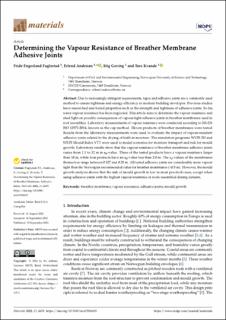| dc.contributor.author | Fuglestad, Fride Engesland | |
| dc.contributor.author | Andenæs, Erlend | |
| dc.contributor.author | Geving, Stig | |
| dc.contributor.author | Kvande, Tore | |
| dc.date.accessioned | 2022-09-27T09:16:57Z | |
| dc.date.available | 2022-09-27T09:16:57Z | |
| dc.date.created | 2022-09-26T09:45:23Z | |
| dc.date.issued | 2022 | |
| dc.identifier.issn | 1996-1944 | |
| dc.identifier.uri | https://hdl.handle.net/11250/3021679 | |
| dc.description.abstract | Due to increasingly stringent requirements, tapes and adhesive joints are a commonly used method to ensure tightness and energy efficiency in modern building envelopes. Previous studies have researched and tested properties such as the strength and tightness of adhesive joints. So far, water vapour resistance has been neglected. This article aims to determine the vapour resistance and shed light on possible consequences of vapour-tight adhesive joints in breather membranes used in roof assemblies. Laboratory measurements of vapour resistance were conducted according to NS-EN ISO 12572:2016, known as the cup method. Eleven products of breather membranes were tested. Results from the laboratory measurements were used to evaluate the impact of vapour-resistant adhesive joints related to the drying of built-in moisture. The simulation programs WUFI 2D and WUFI Mould Index VTT were used to model scenarios for moisture transport and risk for mould growth. Laboratory results show that the vapour resistance of breather membrane adhesive joints varies from 1.1 to 32 m in sd-value. Three of the tested products have a vapour resistance larger than 10 m, while four products have an sd-value less than 2.0 m. The sd-values of the membranes themselves range between 0.027 and 0.20 m. All tested adhesive joints are considerably more vapour tight than the Norwegian recommended value for breather membranes (<0.5 m). However, the mould growth analysis shows that the risk of mould growth is low in most practical cases, except when using adhesive joints with the highest vapour resistance in roofs assembled during autumn. | en_US |
| dc.language.iso | eng | en_US |
| dc.publisher | MDPI | en_US |
| dc.rights | CC BY 4.0 | * |
| dc.rights.uri | http://creativecommons.org/licenses/by/4.0/ | * |
| dc.subject | Breather membrane | en_US |
| dc.subject | Vapour resistance | en_US |
| dc.subject | Adhesive joints | en_US |
| dc.subject | Mould growth | en_US |
| dc.title | Determining the Vapour Resistance of Breather Membrane Adhesive Joints | en_US |
| dc.title.alternative | Determining the Vapour Resistance of Breather Membrane Adhesive Joints | en_US |
| dc.type | Peer reviewed | en_US |
| dc.type | Journal article | en_US |
| dc.description.version | publishedVersion | en_US |
| dc.rights.holder | © 2022 The authors | en_US |
| dc.subject.nsi | VDP::Teknologi: 500 | en_US |
| dc.source.volume | 15 | en_US |
| dc.source.journal | Materials | en_US |
| dc.source.issue | 19 | en_US |
| dc.identifier.doi | 10.3390/ma15196619 | |
| dc.identifier.cristin | 2055256 | |
| dc.relation.project | Norges forskningsråd: 237859 | en_US |
| dc.source.articlenumber | 6619 | en_US |
| cristin.ispublished | true | |
| cristin.fulltext | original | |
| cristin.qualitycode | 1 | |

